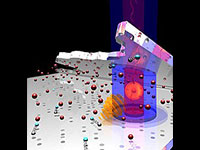Rydberg Excitation
Excitation of atoms using lasers
- Rydberg excitation for quantum optics
- Dipole interaction and dipole blockade
- Electric field measurement
- TOPTICA’s added value
What are Rydberg atoms?
Rydberg atoms are atoms that are highly excited e.g. by laser irradiation, collisions with electrons and are also observed in outer space. Usually, one electron is excited into a state with very high principal quantum number, e.g. n=100 or even much higher. Since the radius (the size) of atom scales with the square of n, Rydberg atoms can become very large, up to the mm scale. They are very sensitive to electric fields and can hence be used to detect the latter. Rydberg atoms were also used to demonstrate and test quantum optics or quantum physics phenomena, like for “Schrödinger cats” or tests of Bells inequality. Being placed within a small electric field, Rydberg atoms can be polarized and show very high electric dipole moments. These high dipole moments can be used to investigate dipole-dipole interaction, e.g. in quantum gases. Based on the so-called dipole blockade, one can also realize single photon sources using narrow linewidth lasers to excite exactly one atom to a Rydberg state.
More detailed information about Rydberg atoms, their transitions and complete laser solutions for these Rydberg atoms can be found in our Rydberg flyer.

